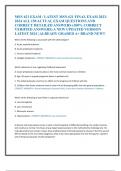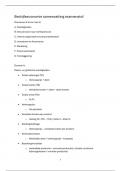MSN 621 EXAM / LATEST MSN 621 FINAL EXAM 2023-
2024 ALL 150 ACTUAL EXAM QUESTIONS AND
CORRECT DETAILED ANSWERS (100% CORRECT
VERIFIED ANSWERS) A NEW UPDATED VERSION
LATEST 2024 | ALREADY GRADED A+ BRAND NEW!!
Which of the following is associated with the CD10 antigen?
A. Acute myeloid leukemia
B. Acute lymphocytic leukemia
C. Chronic myeloid leukemia
D. Hodgkin lymphoma - CORRECT ANSWER-B. Acute lymphocytic leukemia
Which statement is true regarding childhood leukemias?
A. Acute lymphocytic leukemia (ALL) is the most common leukemia in children.
B. Age >10 years is a good prognostic factor in pediatric ALL.
C. The initial leukocyte count has no effect on the prognosis of children with ALL.
D. Children with Down syndrome have a lower risk of developing AML than the general population. -
CORRECT ANSWER-A. Acute lymphocytic leukemia (ALL) is the most common leukemia in children.
Which of the following is least likely in subacute blood loss?
A. Low hemoglobin
B. Low reticulocyte
C. Microcytic anemia
D. Hypervolemia - CORRECT ANSWER-B. Low reticulocyte
A 40-year-old male patient comes in with a chief complaint of difficulty breathing. His cardiac function
test results are normal. He shows airway hyperresponsiveness to the methacholine challenge test. His
lung spirometry test reveals a lower-than-predicted level of forced expiratory volume in the first second
(FEV1). Based on the most likely diagnosis, what is the most appropriate first-line therapy for a patient
with infrequent episodes of mild symptoms?
,1. Albuterol and a low-dose corticosteroid inhaler
2. An inhaler with a combination of formoterol and a corticosteroid
3. Inhaled low-dose corticosteroids
4. Albuterol alone - CORRECT ANSWER-4. Albuterol alone
A 35-year-old previously healthy male presents for evaluation of coryza, dry cough, and fever for 4 days
duration. The patient reports no significant past medical history, takes no daily medications, and has no
known drug allergies. He reports receiving COVID-19 and influenza vaccines this season. Of note, upon
obtaining a travel history, the patient stated that he recently returned from Saudi Arabia. He had petted
a dog and visited a camel farm while on his trip. His vital signs show a temperature of 101 F (38.3 C),
blood pressure of 102/64 mmHg, respiratory rate of 20 breaths per minute, heart rate of 115 beats per
minute, and SpO2 of 95% on room air. Significant findings on the exam include tachycardia, tachypnea,
and mild use of accessory respiratory muscles. Which of the following diagnoses is most important to
consider in this patient?
1. Middle East respiratory syndrome coronavirus (MERS-CoV)
2. Severe acute - CORRECT ANSWER-1. Middle East respiratory syndrome coronavirus (MERS-CoV)
A 39-year-old woman is brought to the emergency department with 2 days history of fever, headache,
severe myalgias, dry cough, breathlessness, and coryza. She is a school teacher, and many students in
her class have been reported sick with "the flu." Physical examination reveals scattered crackles in both
lung fields. Blood tests indicate a white blood cell count of 12,900 cells/microL with 69% lymphocytes.
Chest x-ray shows increased interstitial markings on both sides. She has had rheumatoid arthritis, and
she takes prednisone. Which of the following tests is most likely to confirm the diagnosis in this patient?
1. Urine Legionella antigen
2. Immunofluorescence antibody staining for influenza from blood
3. Rapid influenza diagnostic test from a throat swab
4. Viral cell cultures for influenza virus from a throat swab - CORRECT ANSWER-3. Rapid influenza
diagnostic test from a throat swab
A 65-year-old female with renal cancer presents with dyspnea, fatigue, and dizziness. She is on warfarin
to treat a left leg deep vein thrombosis. Her hematocrit is 22%, hemoglobin is 7.1 g/dL, platelets
109,000/mL, PT 1.3, PTT 36, INR 1.45, and WBC 12,000 mm3. What is the next step in the management
of the patient?
A. Transfuse packed red blood cells
B. Transfuse platelets
,C. Transfuse fresh frozen plasma
D. Give vitamin K - CORRECT ANSWER-A. Transfuse packed red blood cells
A 43-year old female presents for evaluation. Her left knee has been painful and swollen for the past
week. Her symptoms have been worsening, and now she finds it difficult to bear weight. She denies any
trauma or falls. She denies any other joint pain, and a review of systems is otherwise negative except for
an annular rash that she had on the upper back about one month ago that resolved on its own. Past
medical history and family history are unremarkable. On exam, her vital signs are normal. The left knee
is erythematous, has an effusion, and is tender. The range of motion is limited in flexion and extension.
The rest of the exam is normal. Laboratory evaluation shows a normal complete blood count, liver
function, and renal function. Her erythrocyte sedimentation rate is 44 mm/hr. Rheumatoid factor, ANA,
Anti-CCP are negative. Synovial fluid analysis reveals 12,000 white blood cells/mm3 and no crystals.
Bacterial c - CORRECT ANSWER-1. Serological studies for infectious etiology
A 65-year-old woman presents with an 8-month history of recurrent low-grade fevers, a 3-month history
of abdominal fullness, and more recently, fatigue and moderately reduced exercise tolerance. Before
this, she was in good health with no major medical conditions. Upon examination, she appeared to be
stable and in no acute distress. She has a heart rate of 95 bpm and blood pressure of 128/60 mmHg. She
had several palpable cervical and axillary lymph nodes (1-2 cm) that were non-tender and freely mobile.
She also had palpable splenomegaly. No other abdominal masses/hepatomegaly appreciated on
examination. Her complete blood count showed a leukocyte count of 32,000/mm3, hemoglobin of 9.8
g/dL, platelet count of 145,000/mm3, neutrophil count 1,900/mm3, lymphocyte count 30,000/mm3,
elevated LDH, and elevated reticulocyte count. Peripheral blood smear showed an increasing number of
mature lymphocytes, spherocytes, and pol - CORRECT ANSWER-2. Autoimmune hemolytic anemia
A 45-year-old asymptomatic man is found to have leukocytosis on a preoperative complete blood count.
His physical examination is significant for the spleen tip being palpable 2 cm below the left costal
margin. Enlarged, rubbery, nontender lymph nodes up to 1.5 cm in size are present in the axillae and
inguinal regions. Laboratory workup reveals a hemoglobin of 13.3 g/dL, leukocytes 40,000/microliter,
and platelets 238,000/microliter. His peripheral blood smear shows mature lymphocytes with smudge
cells. If he fails first-line therapy, which of the following cytogenetic changes would be an indication for
stem cell transplant in this patient?
1. Trisomy 12
2. 13q deletion
3. 17p deletion
4. 19p deletion - CORRECT ANSWER-3. 17p deletion
, An otherwise healthy 17-year-old male presents for an initial evaluation after recently immigrating from
Sudan, Africa. He says he has received all the necessary vaccinations, including the BCG vaccine. Further
inquiry reveals his sister was treated for tuberculosis seven years ago. He is not sexually active, takes no
medications, and does not drink alcohol, use illicit drugs, or smoke cigarettes. What is the most
appropriate next step in evaluation?
1. Interferon-gamma release assay
2. Mantoux tuberculin skin test
3. Chest x-ray
4. Induced sputum culture for AFB - CORRECT ANSWER-1. Interferon-gamma release assay
A 35-year-old man complains of cough and low-grade fever for the past 3 months. The patient
developed a fever 3 months ago, which was low-grade and associated with night sweats. He also has
had a troublesome cough. He had an episode of hemoptysis, which prompted the visit. His history is
significant for HIV infection 8 years ago, for which he has never taken treatment. Examination reveals a
temperature of 99 °F (37.2 °C), a pulse of 90 beats per minute, a blood pressure of 110/70 mmHg, and a
respiratory rate of 22 breaths per minute. His general physical examination reveals the presence of
oropharyngeal thrush and mild pallor. Chest examination reveals coarse crackles and bronchial
breathing in the left upper lobe. His investigations revealed a WBC count of 3,000 per microL,
hemoglobin of 10 gm/dl, platelet count of 150,000 per microL, erythrocyte sedimentation rate of 50 mm
per hour, serum creatinine of 0.8 mg/dl an - CORRECT ANSWER-3.
Start antitubercular treatment (ATT) now and antiretroviral therapy (ART) after 2 weeks
A 65-year-old man with metastatic lung cancer presents with complaints of dyspnea, dry cough, and
chest pain that is exacerbated on inspiration. His blood pressure is 110/70 mmHg, heart rate 90/min,
respiratory rate 26/min, and he is afebrile. A chest x-ray shows hyperinflation of the left lung. The
patient has most likely developed which of the following complications?
1. Primary spontaneous pneumothorax
2. Secondary spontaneous pneumothorax
3. Tension pneumothorax
4. Pleural effusion - CORRECT ANSWER-2. Secondary spontaneous pneumothorax
A 43-year-old man presents to the clinic for evaluation after abnormalities noted on a routine set of
labs. CBC with differential demonstrated hemoglobin 14 g/dL, WBC count 26,000/microL, lymphocytes
21,000/microL, neutrophils 4500/microL, and platelets 260,000/microL. The basic metabolic panel
demonstrates normal electrolytes and renal function. LFTs show total bilirubin 1.2 mg/dL and normal
liver enzymes. On examination in office, his examination is normal, with no palpable lymph nodes or





